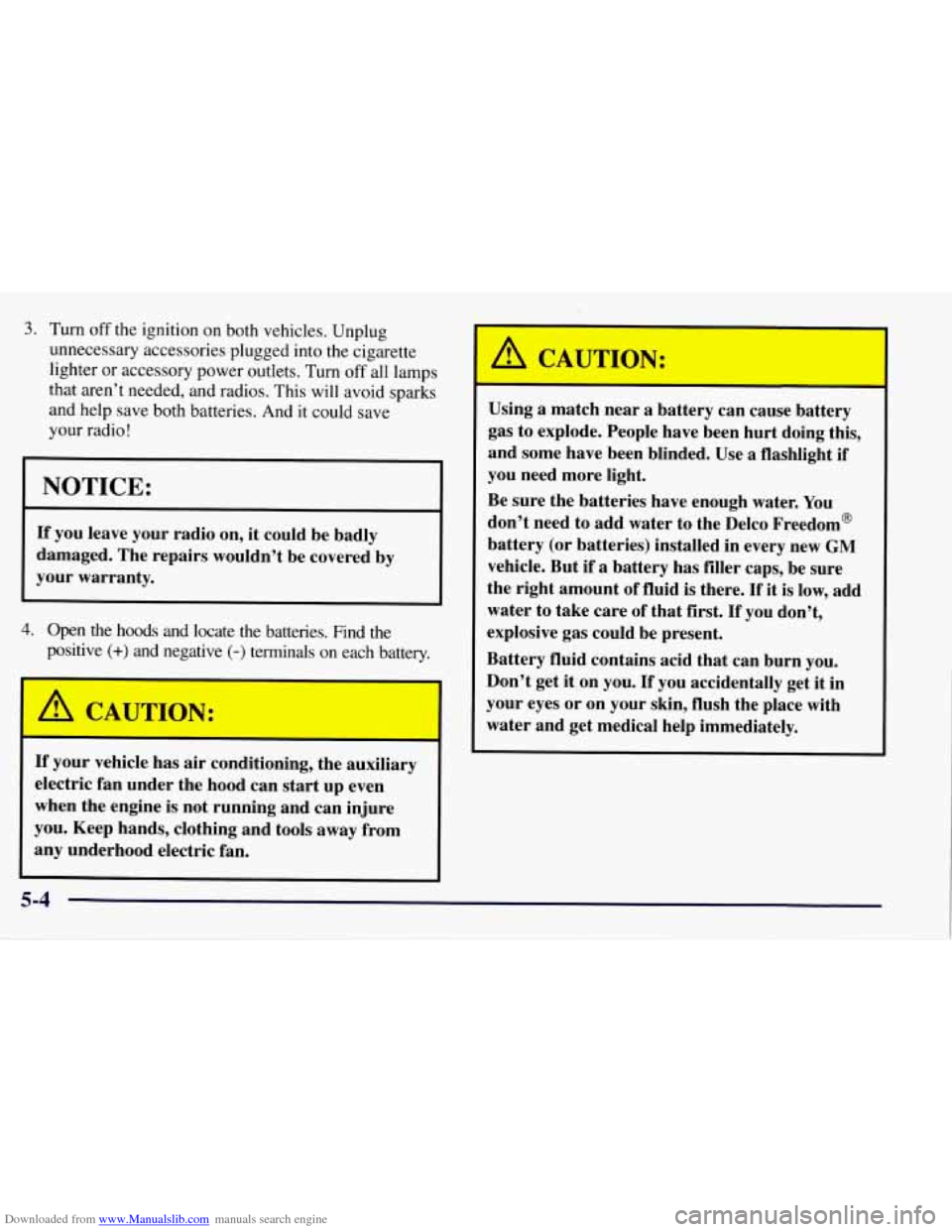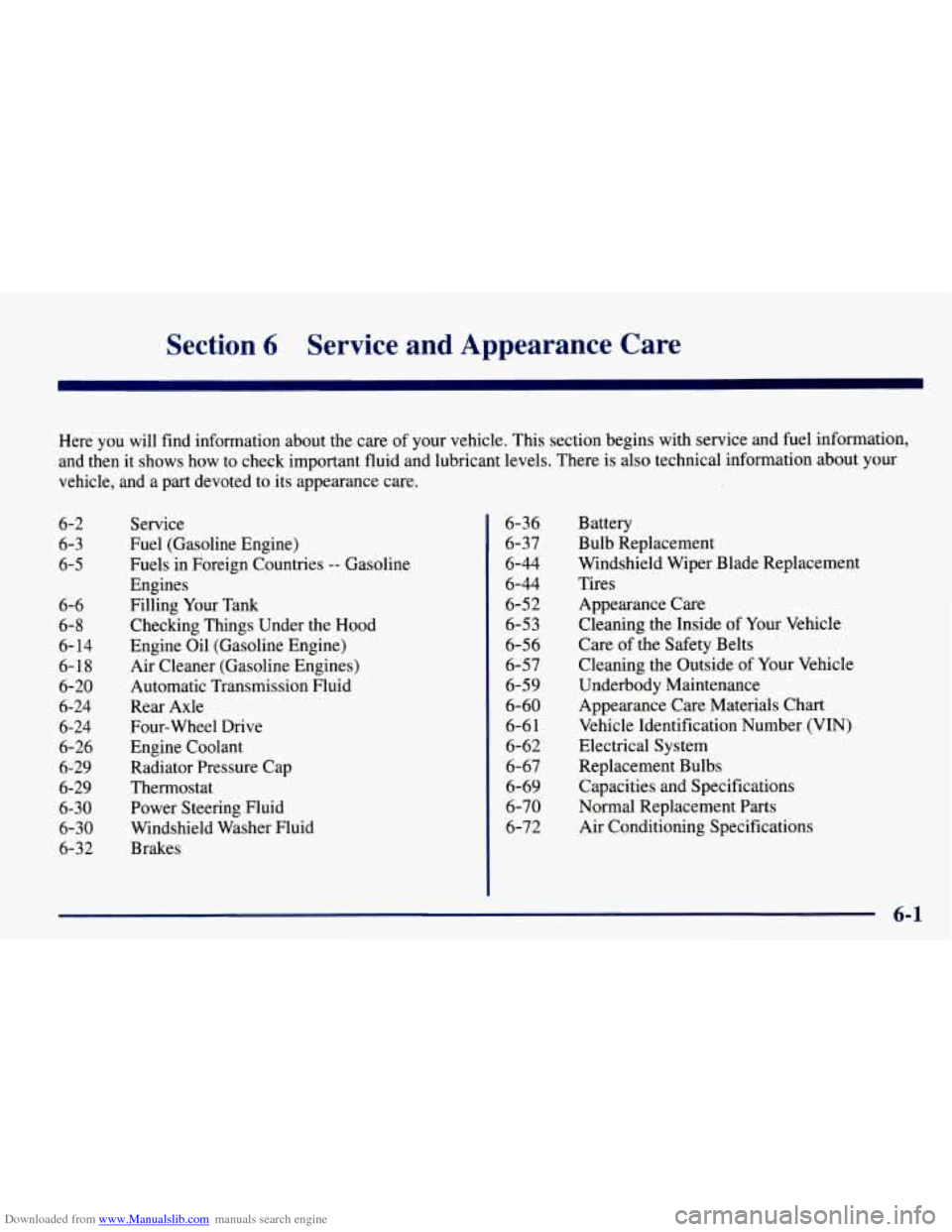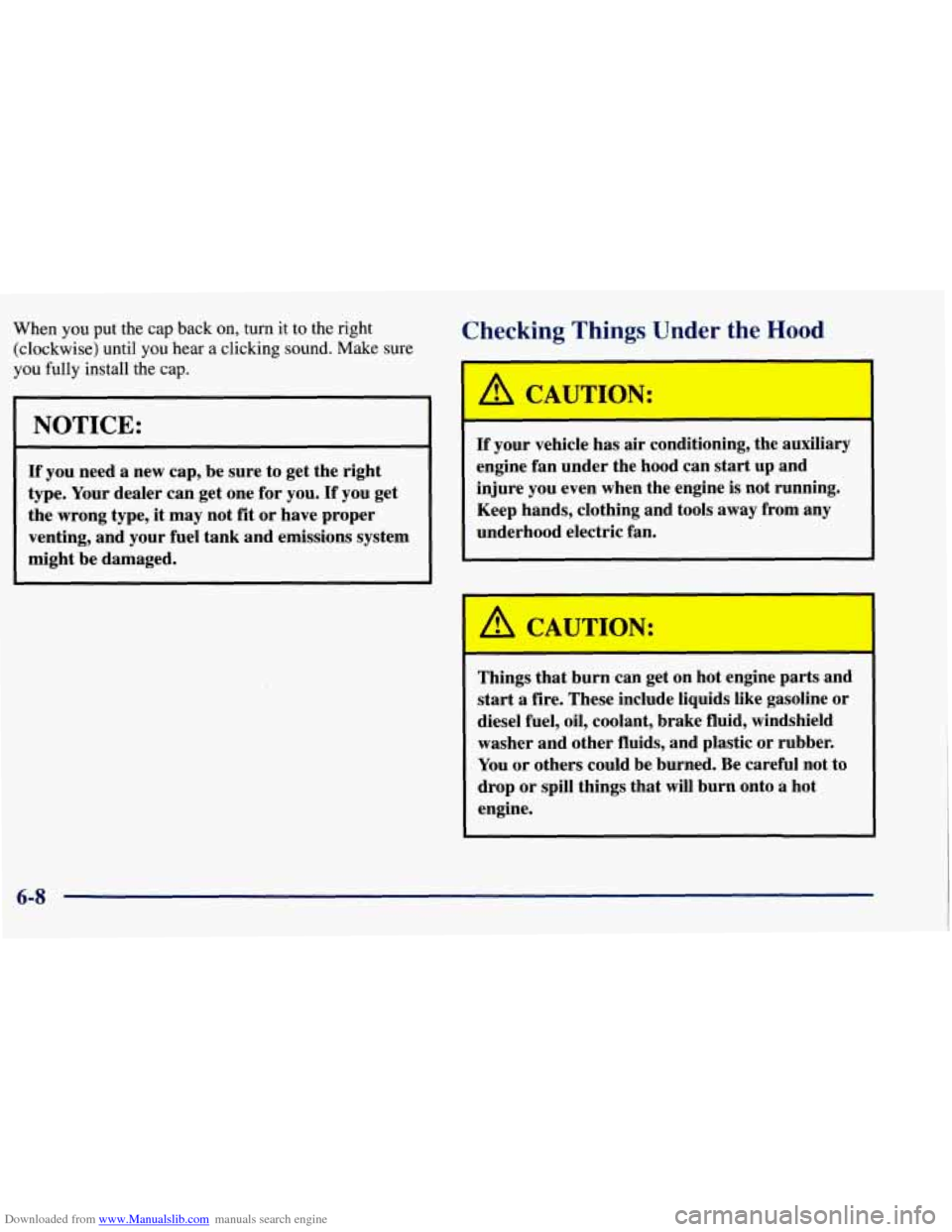Page 241 of 433

Downloaded from www.Manualslib.com manuals search engine 3. Turn off the ignition on both vehicles. Unplug
unnecessary accessories plugged into the cigarette
lighter or accessory power outlets. Turn
off all lamps
that aren’t needed, and radios. This will avoid sparks
and help save both batteries. And
it could save
your radio!
NOTICE:
If you leave your radio on, it could be badly
damaged. The repairs wouldn’t be covered by
your warranty.
4. Open the hoods and locate the batteries. Find the
positive
(+> and negative (-) terminals on each battery.
~ If your vehicle has air conditioning, the auxiliary
electric fan under the hood can start up even
when the engine is not running and can injure
you. Keep hands, clothing and tools
away from
any underhood electric fan.
I
Using a match near a battery can cause battery
gas to explode. People have been hurt doing this,
and some have been blinded. Use
a flashlight if
you need more light.
Be sure the batteries have enough water.
You
don’t need to add water to the Delco Freedom@
battery (or batteries) installed in every new
GM
vehicle. But if a battery has filler caps, be sure
the right amount
of fluid is there. If it is low, add
water to take care of that first.
If you don’t,
explosive gas could be present.
Battery fluid contains acid that can burn you.
Don’t get it on you.
If you accidentally get it in
your eyes or on your skin, flush the place with
water and get medical help immediately.
5-4
Page 250 of 433
Downloaded from www.Manualslib.com manuals search engine Cooling System -- Gasoline Engines
When you decide it’s safe to lift the hood, here’s what
you’ll see:
A. Coolant Recovery Tank
B. Radiator Pressure Cap
C. Engine Fan(s)
LA
CAUTION:
I
If your vehicle has air conditioning, the auxiliary
electric fan under the hood can start up even
when the engine is not running and can injure
you. Keep hands, clothing and tools away from
any underhood electric fan.
If the coolant inside the coolant recovery tank is boiling,
don’t do anything else until it cools
down.
5-13
Page 280 of 433

Downloaded from www.Manualslib.com manuals search engine Section 6 Service and Appearance Care
Here you will find information about the care of your vehicle. This section begins with service and fuel information,
and then it shows how to check important fluid and lubricant levels. There is also technical information about your
vehicle, and a part devoted to its appearance care.
6-2
6-3
6-5
6-6
6-8
6- 14
6-18
6-20
6-24 6-24
6-26
6-29
6-29
6-30
6-30
6-32 Service
Fuel (Gasoline Engine)
Fuels
in Foreign Countries -- Gasoline
Engines
Filling Your Tank
Checking Things Under the Hood
Engine Oil (Gasoline Engine)
Air Cleaner (Gasoline Engines)
Automatic Transmission Fluid
Rear Axle
Four-wheel Drive
Engine Coolant
Radiator Pressure Cap
Thermostat
Power Steering Fluid
Windshield Washer Fluid
Brakes
6-36
6-37
6-44
6-44
6-52
6-53
6-56
6-57
6-59
6-60 6-6 1
6-62
6-67
6-69
6-70
6-72 Battery
Bulb Replacement
Windshield Wiper Blade Replacement
Tires Appearance Care
Cleaning the Inside
of Your Vehicle
Care of the Safety Belts
Cleaning the Outside of Your Vehicle
Underbody Maintenance
Appearance Care Materials Chart
Vehicle Identification Number (VIN)
Electrical System
Replacement Bulbs
Capacities and Specifications
Normal Replacement Parts
Air Conditioning Specifications
6-1
Page 287 of 433

Downloaded from www.Manualslib.com manuals search engine When you put the cap back on, turn it to the right
(clockwise) until you hear a clicking sound.
Make sure
you fully install the cap.
NOTICE:
If you need a new cap, be sure to get the right
type. Your dealer can get one for you.
If you get
the wrong type, it may not
fit or have proper
venting, and your fuel tank and emissions system
might be damaged.
Checking Things Under the Hood
'
A CAUTION:
If your vehicle has air conditioning, the auxiliary
engine fan under
the hood can start up and
injure you even when the engine is not running.
Keep hands, clothing and tools
away from any
underhood electric fan.
A CAUTION:
I I
Things that burn can get on hot engine parts and
start a fire. These include liquids like gasoline or
diesel fuel, oil, coolant, brake fluid, windshield
washer and other fluids, and plastic or rubber.
You or others could be burned. Be careful not to
drop or spill things that will burn onto a hot
engine.
6-8
Page 288 of 433
Downloaded from www.Manualslib.com manuals search engine Hood Release
To open the hood,
first pull the handle
inside the vehicle.
I
Then go to the front of the vehicle and pull up on the
secondary
hood release, located just to the passenger’s
side
of the center of the grill.
Lift the hood.
If your vehicle has air conditioning, it may have an
auxiliary engine fan in addition to the belt driven fan.
Before closing the hood, be sure all filler caps are on
properly. Pull down the hood and close it firmly.
6-9
Page 315 of 433

Downloaded from www.Manualslib.com manuals search engine Fluid Leak Check
After the vehicle has been parked for a while, inspect
the surface under the vehicle for water, oil, fuel or other
fluids. Water dripping from the air conditioning system
after
it has been used is normal. If you notice fuel leaks
or fumes, the causes should be found and corrected
at once.
Battery
Every new vehicle has a Delco Freedom@ battery. You
never have to add water to one of these. When it’s time
for a new battery, we recommend a Delco Freedom
battery. Get one that has the replacement number shown
on the original battery’s label.
Vehicle Storage
If you’re not going to drive your vehicle for 25 days
or more, take off the black, negative
(-) cable from
the battery. This will help keep your battery from
running down.
/d CAUTION:
Batteries have acid that can burn you and gas
that can explode. You can be badly hurt if
you
aren’t careful. See “Jump Starting” in the Index
for tips on working around a battery without
getting hurt.
Contact your dealer to learn how to prepare your vehicle
for longer storage periods.
Also, for your audio system, see “Theft-Deterrent
Feature” in the Index.
6-36
Page 345 of 433
Downloaded from www.Manualslib.com manuals search engine Name
ECM-B
RR DEFOG
IGN-E
Circuits Protected
Fuel Pump, PCMNCM
Rear Window Defogger
Auxiliary Fan Relay Coil,
A/C Compressor Relay,
Hot Fuel Module
Name
FUEL SOL
GLOW PLUG
HORN
AUX FAN
ECM-
1
AIC ENG-
1
LIGHTING
BATT
IGN-A IGN-B
ABS
BLOWER
STOP/HAZ
Circuits Protected
Fuel Solenoid (Diesel Engine)
Glow plugs (Diesel Engine)
Horn, Underhood Lamps
Auxiliary Fan
Injectors, PCMNCM
Air Conditioning
Ignition Switch, EGR, Canister
Purge, EVRV Idle Coast Solenoid,
Heated
02, Fuel Heater
(Diesel Engine), Water Sensor
(Diesel Engine)
Headlamp and Panel Dimmer
Switch, Fog and Courtesy Fuses
Battery, Fuse Block Busbar
Ignition Switch
Ignition Switch Anti-Lock Brake Module
Hi Blower and Rear
Blower Relays
Stoplamps
6-66
Page 351 of 433
Downloaded from www.Manualslib.com manuals search engine Fuel Tank Capacity (Approximate)
TYPE QUANTITY
GasolineDiesel
Utility
- Standard
Suburban
- Standard
30 Gallons (1 13 L)
42 Gallons (159 L)
Air Conditioning Refrigerants
Not all air conditioning refrigerants are the same.
If the air conditioning system in your vehicle needs
refrigerant, be sure the proper refrigerant is used.
If you’re not sure, ask your GM dealer.
See refrigerant charge label under the hood for charge
capacity information and requirements.
6-72